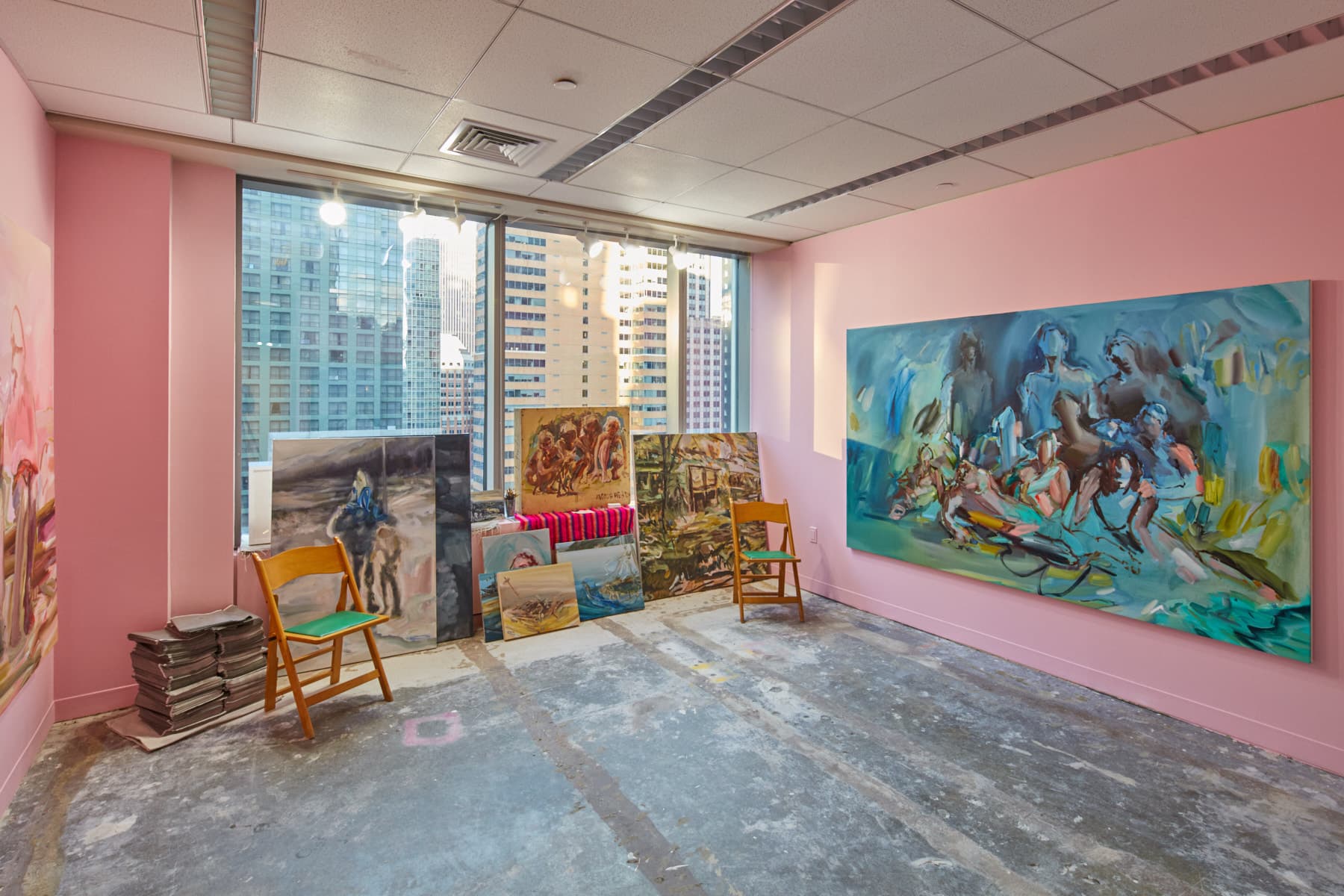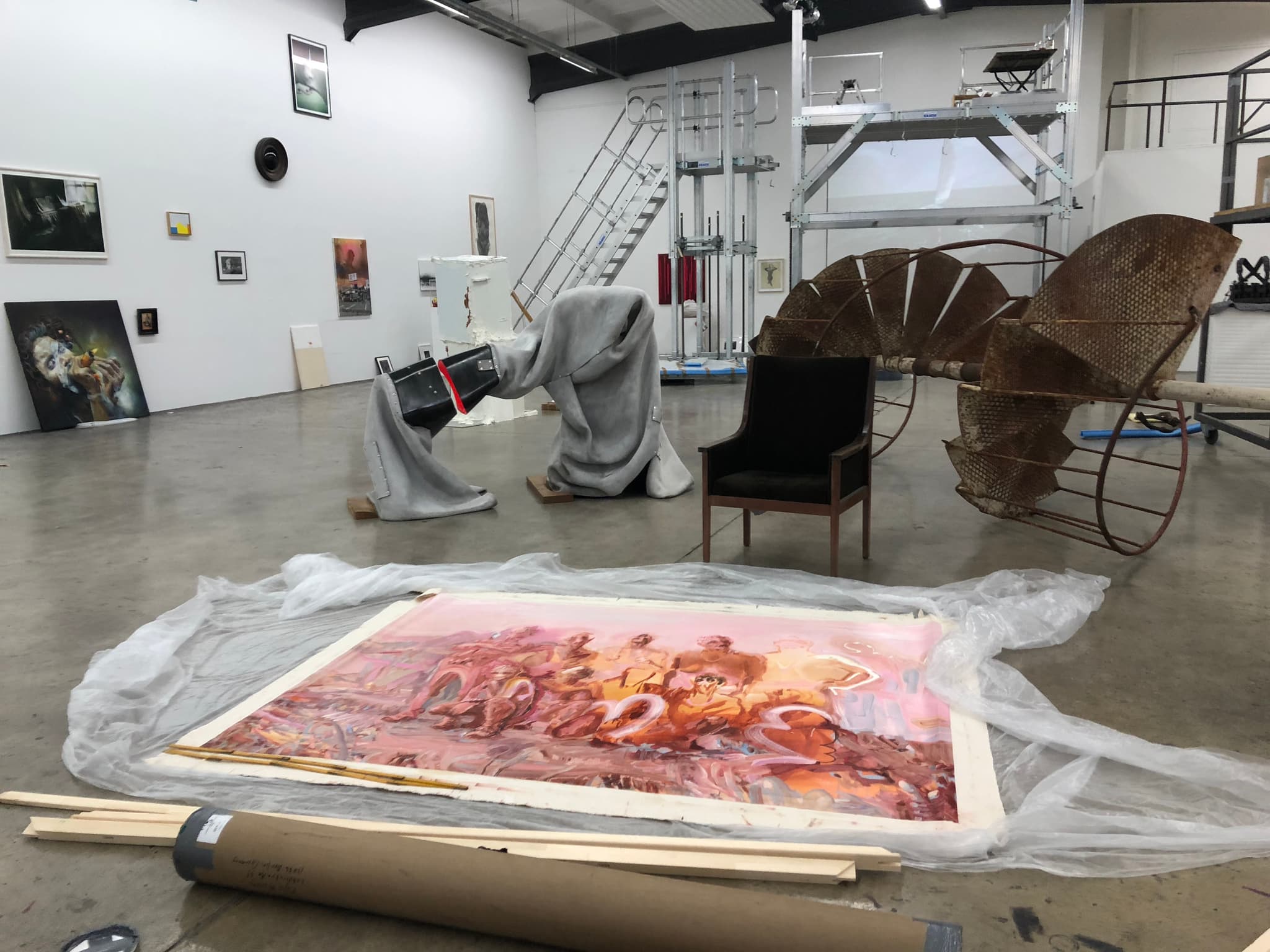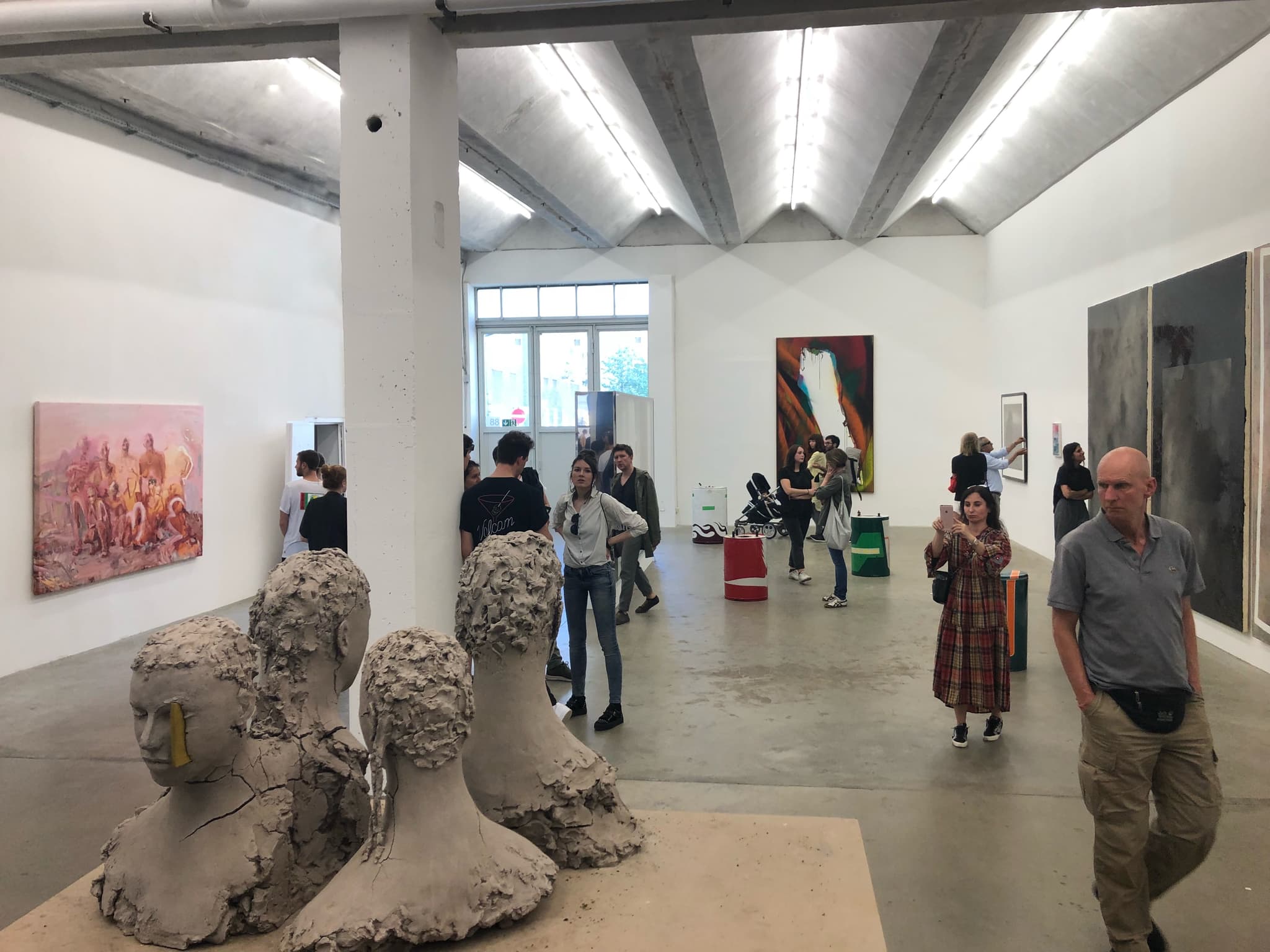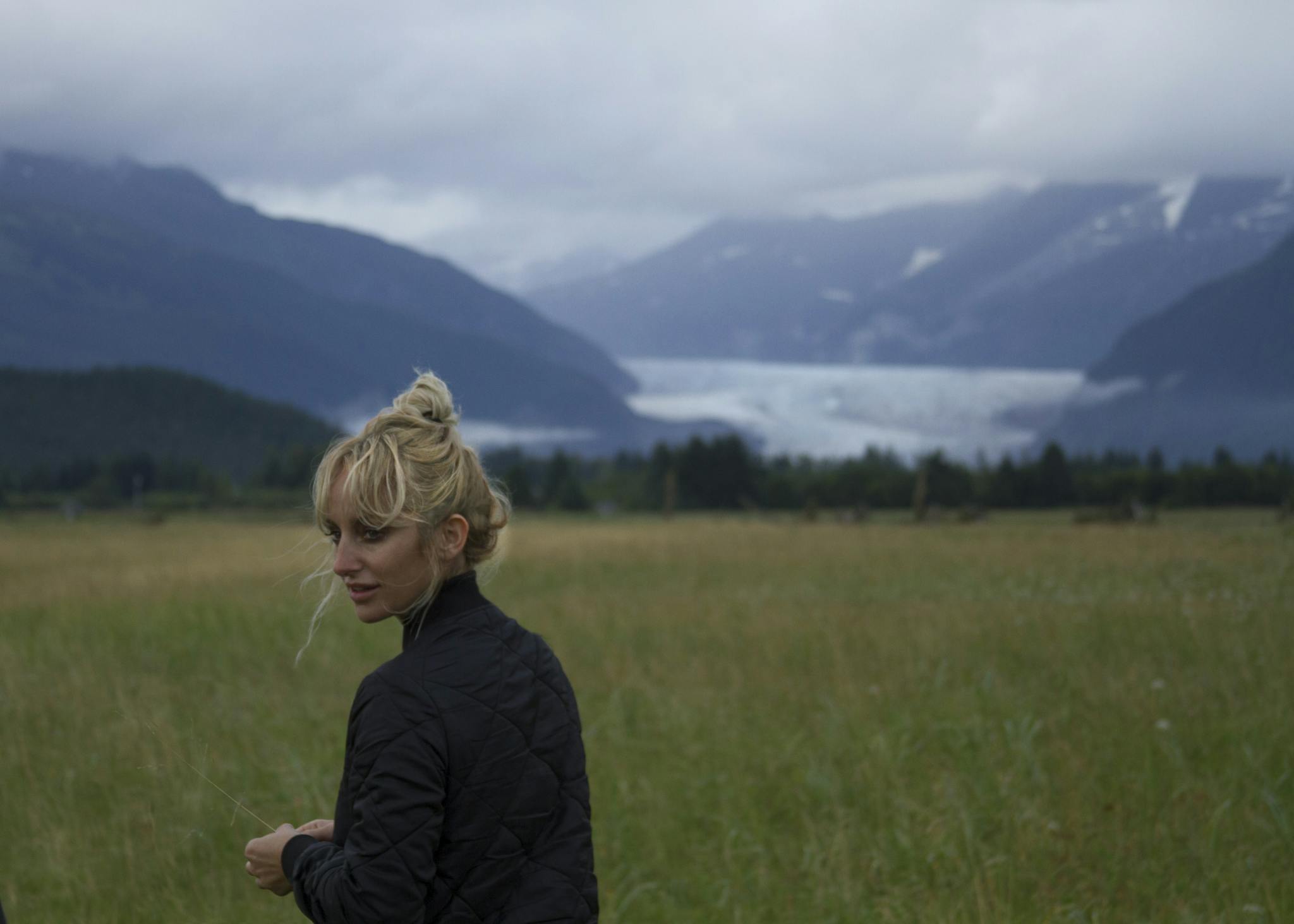A sense of place has long influenced painter Kylie Manning’s work who, raised between Mexico and Alaska, has a unique relationship to geographical belonging. After an introduction by Manning’s curator—fellow artist and Alaskan Patrice Helmar—I was struck by Manning’s treatment of boundlessness; exploring the tension between containment and fluidity through form.
In Manning’s paintings, the magic is in the space between: whether navigating the relationship between spaghetti Westerns and German wildness or engaging in a technical style that is both joyously loose and scrupulously defined. While exhibiting in New York and Berlin, Manning and I spoke about the artist’s larger-than-life work which grabs on and gazes back.

Kylie Manning, “No.6 (Olive, Sienna, Umber on Mulberry).” Courtesy of the artist.
How does your work respond to space?
My paintings are all about creating space. My goal is to utilize temperature and light in a way that invites viewers to remember a time when the light was just so. This buys me room to be quite a bit more abstract in my figuration, which allows for a universality in origin and orientation. If I can capture a specific light, it transports people into the space. Then they can meet the abstracted figures in a less objective way.
What interests you about space as a concept?
Space has always been a source of interest for my work—having been raised half in a small fishing town in Alaska, and half in a small fishing town in Mexico. My parents chose these off the grid locations for the actual sense of space, breathability, openness. They wanted us to have a sense of cultural relativity in place, community, and nature (also they were hippies who loved to surf). I worked on commercial fishing boats for years and would be out on the ocean for large chunks of time. We made a conscious choice to come back to land. I think like most Alaskans, I feel at home in massive wild spaces. I’m overly claustrophobic, and adore being alone.
How do you conceive of scale in relation to your work?
I make large scale oil paintings because the scale I am used to being around is twice my size. Yes the people all around me have influenced everything I do but the spaces I’ve been privy to are in everything I make. After grad school I was sent to work in Leipzig, Germany and space came to the forefront again. I hope people get lost in the dusky gendered colors in my paintings and are transported to a space that could be.

Installation view of Manning’s work, curated by Patrice Helmar, at SPRING/BREAK Art Show 2018. Courtesy of the artist and SBAS.
Tell us about this particular body of work.
I wanted to recreate a version of the keyhole psychology in people’s personal viewing experience. The oversized paintings are populated with packs of people that are looking back at the viewer, while the viewer is actually on the inside of a series of multiple figurative compositions that reflect the process of looking and measuring. The masterpiece scale disassociates the idea of masters with masterpieces while the crystallized gestural figures oppose a minimizing gaze.
Your work blurs the line between figuration and gestural abstraction. What interests you about this approach?
I think my interest being smack dab between figuration and abstraction comes from my upbringing in multiple places: I’m a romantic and always want a bit of both. I was raised by extremely well versed art teachers. So, to be honest, I don’t know why or how because I don’t remember a time when I wasn’t engaging in this way. The apple didn’t fall very far from the tree. I’ve always been investigating this way, and I’ve just gone farther down the rabbit hole.
What pushed you down that particular rabbit hole?
My time spent in Leipzig around so many great and weird figurative painters certainly pushed me along. There is a very different response to American minimalist painting in Germany. But I think it goes farther back. I grew up around Tlingit formline and Xuichol color and have dedicated my life to learning about image making. There is a mystery in the middle of abstraction and figuration that allows me to explore contrasting qualities I enjoy: masculine yet feminine, formal yet unabashed, emotional yet reserved, solemn yet humorous. Also, I make my best work in response to something: a sketch, a photo, an image of some sort—when I jump off of and a push against something, my brushwork is more inventive. When I work without trying to interact with something, my brushwork becomes very limited. I have been enjoying these multiple figure compositions because the figures fade into the architecture of the piece becoming a pure compositional decision.
How has your practice been influenced by your time spent in Germany?
My time spent in Germany had a great influence on my work, being surrounded by a community of artists who encouraged and believed in one another had a huge impact my process. I saw a place that supported artists and craftsmen in a serious way, a culture that prioritized the arts, and an art world that had a completely unique relationship to the last 50 years of art history.
What motivated your move to Leipzig?
I had been sent over by Eileen Guggenheim and the NY Academy of Art and was set up with a studio in the Spinnerei in Leipzig. It was a gift. I had just sold a few paintings so it was the first time in my life when I could paint as my full time job. I lived humbly but relished waking up and working all day and then studying art theory every evening without distraction or agenda.

Kylie Manning, “No. 7 (Green, Maroon, Brown).” Courtesy of the artist.
Did this particular experience affect your work stylistically or conceptually?
The depth of my work and the quality of my handling immediately jumped up a notch; I was able to build a bridge between good painting and smart painting. My works began to reflect upon the process of image making. I began to explore my own stereotype as an Alaskan/American in Germany and began to unravel the assumptions of true grit being a doubled sword of bravery and idiocy.
How so?
I started painting ‘western’ imagery and read Karl May novels. May was a man who wrote about the ‘Wild West’ without having ever left east Germany—he pretended his novels were travel guides when in fact they were from his imagination. In fact, his stories went on to become spaghetti westerns starring people like John Wayne and Clint Eastwood. The proposed idea being that a great deal of what was considered and glorified in Germany as the ‘Wild West’ was actually from one man’s [very limited] imagination.
From these silly, wonky figurative landscapes I began to play with humor and gravity, developing paintings with a bit more consciousness. Being around so many great male painters, I also was able to further dismantle the idea of masterpieces being associated with males through working in a massive scale.
Does this approach still resonate with you now?
Now, years later, themes still pop up from my time in East Germany. At the moment, I find a great deal of the photos of my childhood in Mexico and Alaska are informing my compositions. Lately, I’ve been studying a way to push figuration into a raw version of gesture. I’m trying to hone in on color and light and paint oils like Sumi-e. I can’t say I know what I want to work on next, just that I want to work with this furious frenetic momentum and then see what happens. Themes pop in and out but it always seem to come back to this core push and pull between wildness and structure, form and anti-form, information and implication.

On floor: Manning’s work on loan from the McAllister Collection, re-stretched at Jonas Burgert’s studio in Berlin April 2018.
Could you tell us about your recent exhibition “NGORONGORO II” in Berlin.
My exhibition kicked off during Berlin’s Gallery Weekend. I’ve been curated as a part of the group show NGORONGORO II, which refers to a collapsed volcanic crater in Tanzania. I was thrilled to be a part of it as the artists and curators involved are people I adore and admire.
If time and money were no object, and travel was covered, what would be your dream piece to create and where?
If I had time and money were no object I’d be all over: spring on a barge off the coast of Morocco, summer in a cabin in Alaska, fall in New York, and winter in Mexico. Obviously, if I had my druthers, I’d have huge studios attached to my apartments (à la Diego Rivera) in all of these places. The bouncing around would lend objectivity to all of the work so that nothing could become too precious or over-worked.

Installation view of NGORONGORO II, 2018.
Stay tuned with Kylie by following her on instagram or visiting her site.





